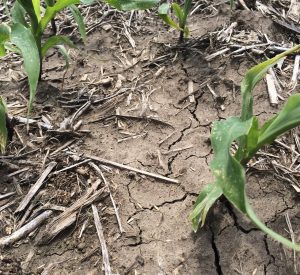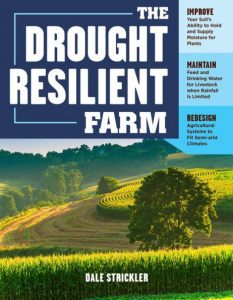The Drought Resilient Farm
 The usual strategies for dealing with drought have been to either complain at the coffee shop or pray for rain. No one likes a complainer, and while we aren’t opposed to praying for rain, it probably should not be your only strategy. The Lord helps those who help themselves, and it would sure be helpful to have a book with the information necessary to deal with a drought. In a country with a history of being devastated by the Dust Bowl, one would think that there would be an abundance of books written on managing drought on farms and ranches. While there are plenty of books on managing home gardens in a drought, there has never been a book targeted to helping commercial farmers and ranchers survive drought. That has now changed.
The usual strategies for dealing with drought have been to either complain at the coffee shop or pray for rain. No one likes a complainer, and while we aren’t opposed to praying for rain, it probably should not be your only strategy. The Lord helps those who help themselves, and it would sure be helpful to have a book with the information necessary to deal with a drought. In a country with a history of being devastated by the Dust Bowl, one would think that there would be an abundance of books written on managing drought on farms and ranches. While there are plenty of books on managing home gardens in a drought, there has never been a book targeted to helping commercial farmers and ranchers survive drought. That has now changed.
 Beginning in June of 2018, The Drought Resilient Farm (published by Storey Publishing and written by our own Dale Strickler) will be available for purchase through Green Cover Seed. The book begins by explaining how to manage soil to improve drought tolerance, with techniques to improve rainfall infiltration, water-holding capacity, and the ability of plants to develop a deeper and more efficient root system. This section will cover many of the myths and misconceptions surrounding practices that we have historically used that have actually been counterproductive to drought tolerance. The second section deals with low-cost or no-cost methods for providing water and feed for livestock in a drought. Traditional advice has centered around either buying expensive hay or selling the herd off at rock-bottom prices, this book gives practical and innovative alternative strategies to those two unpleasant routes. The third section focuses on the Great Plains, the area most devastated by the Dust Bowl, and the area still most susceptible to drought today. This section explains why the current system of agriculture in the area is so vulnerable to drought; more importantly, it lays out a plan to create a system of farming and ranching that is both more resilient and more profitable than what currently exists. After reading this book, you will have far less reason to complain about lack of rain, but we are just fine with you praying for it. In fact, it might help your neighbors who haven’t read this book!
Beginning in June of 2018, The Drought Resilient Farm (published by Storey Publishing and written by our own Dale Strickler) will be available for purchase through Green Cover Seed. The book begins by explaining how to manage soil to improve drought tolerance, with techniques to improve rainfall infiltration, water-holding capacity, and the ability of plants to develop a deeper and more efficient root system. This section will cover many of the myths and misconceptions surrounding practices that we have historically used that have actually been counterproductive to drought tolerance. The second section deals with low-cost or no-cost methods for providing water and feed for livestock in a drought. Traditional advice has centered around either buying expensive hay or selling the herd off at rock-bottom prices, this book gives practical and innovative alternative strategies to those two unpleasant routes. The third section focuses on the Great Plains, the area most devastated by the Dust Bowl, and the area still most susceptible to drought today. This section explains why the current system of agriculture in the area is so vulnerable to drought; more importantly, it lays out a plan to create a system of farming and ranching that is both more resilient and more profitable than what currently exists. After reading this book, you will have far less reason to complain about lack of rain, but we are just fine with you praying for it. In fact, it might help your neighbors who haven’t read this book!